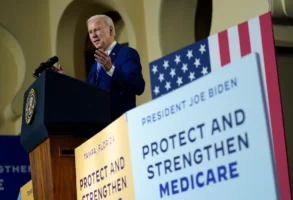
Published November 6, 2018
Much has been written about the Democratic party’s surge in support in America’s suburbs, especially among college-educated women. But this will take them only so far. To have any chance of recapturing the Senate or obtaining a strong majority in the House, the Democrats will need to regain support among a very different type of person: the Obama-Trump voter.
President Trump and the Republican party owe their current dominance to this person. Data from the Voter Study Group show that 9% of Obama’s 2012 voters, nearly 6 million people, switched to Trump in 2016.
They were largely white people without four-year college degrees, and their strategic placement in the midwest allowed Trump to win five of the midwestern states that had backed Obama twice, thereby giving Trump an electoral college majority and the presidency. These voters also backed Republicans for the Senate in Wisconsin and Pennsylvania, allowing them to scrape to victory. Without the Obama-Trump voter, there is no Trump and no Republican Senate majority.
The Obama-Trump voters sit between the two parties’ bases on a host of issues. Lee Drutman, a scholar at New America, has shown that on views of Muslims, immigration, gender roles, and racial or ethnic minorities, they are much closer to Republicans than they are to their former party. On issues regarding the welfare state and economic inequality, they stand much closer to the Democrats. On government intervention in the economy and on general moral issues, they are firmly in the middle.
These tendencies mean that Obama-Trump voters have moved back and forth in their views on Trump during his presidency. In 2017, when the administration was working towards traditional Republican economic priorities such as cutting taxes and limiting entitlements, Trump had a job approval rating of less than 70% job approval among Obama-Trump voters.
But by May 2018, after the administration shifted its emphasis to Obama-Trump voter priorities such as immigration and trade, Trump’s approval rose to 76%. The news since then probably reinforced these views – in particular, the president’s renegotiation of the Nafta treaty, which fulfills one of his promises to this group, and his opposition to the caravan of Central American migrants, which reinforces another.
Support for the president has not, however, automatically translated into support for Republicans. The May 2018 Voter Study Group survey found that only 41% intended to back Republicans for Congress despite their very high level of support for Trump. Forty-four per cent said they either were unsure which party to support or intended to back neither party’s nominee.
Their votes are crucial to Democratic hopes to retake the Senate and sweep to victory in the House. Democrats are defending 10 Senate seats in states Trump won; all of them contain large numbers of Obama-Trump voters. Democrats need to gain 23 seats to retake the House, and there are only 25 Republican-held House seats in districts that Hillary Clinton carried. So if Democrats want anything more than a slim majority, they need to win a fair number of the 12 Republican-held Obama-Trump districts.
The evidence so far is mixed regarding how these voters will break. Nate Silver of fivethirtyeight.com recently found that Democrats led or were tied in six of those 12 races. That’s nowhere near as well as they were doing in the GOP/Clinton seats, where Democrats led virtually all of the contests. But it’s enough to push the potential Democratic House majority to a more comfortable 10 to 15 seats.
The Senate is a different story. The Democratic candidate leads in all five Obama-Trump states, four of them by large enough margins to essentially wrap up the election. Democrats furthermore lead in three of the five states that backed both Romney and Trump. The margins for Trump were much greater in each, though, showing that the Obama-Trump voter is key to victory even in these more classically Republican areas. If Democrats can win over these voters and pick up three Republican-held seats, they have a chance to gain control of the Senate.
These figures may paint too rosy of a picture for the Democrats, however. The New York Times has partnered this cycle with Siena College to conduct an unprecedented number of polls in hot races. The Republican candidate is running well behind Trump’s job approval rating in all eight Obama-Trump districts they have polled in the last two weeks. In five of them, Trump’s job approval rating is higher than the percentage that wants the Republican party to control the House. Both findings suggest Republicans have more of a chance than do Democrats to gain these voters’ support in the final days.
Democrats will do well on election day, largely thanks to the suburban swing that has received so much attention. But if they don’t win a House majority or if they do but lose a fair number of seats in the Senate, their failure to recapture the Obama-Trump voter will be a big reason why.
Henry Olsen is a senior fellow at the Ethics and Public Policy Center.








